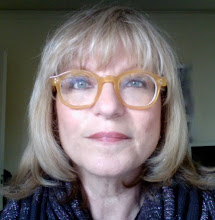Monday, July 23, 2012
Another Place
I wouldn't blame you for seeing these photos and thinking we'd gone to Morocco again. La Mosquée de Paris looks like it might have been lifted from North Africa and dropped in the 5th arrondissement, tiles, courtyards, fountains and all.
Lovely intricate plasterwork, colorful tiles, quiet arcaded hallways make the mosque a shelter from the traffic noise and bustle just outside.
There's an entry fee of 3 Euros that goes to the upkeep of the grounds and the non-Muslim visitor is welcome to go anywhere but the prayer rooms. On the day we wandered in after a visit to the nearby Jardin des Plantes, the few visitors were scattered through the grounds and we felt quite alone.
A tea room and garden with a separate entrance at the rear of the mosque grounds serves mint tea in typical small glasses for a few euros more and very good Magrebien pastries are available to accompany it. There's a restaurant as well for more elaborate fare, decorated in traditional style. It would be a great place for a party, though I have no idea of the quality of the food.
This is an unexpected departure from daily life here, one that doesn't require a plane flight or security lines to allow you to feel transported to another place.
It's almost a surprise to walk back out and find yourself on a residential street in Paris.
Thursday, July 19, 2012
They Were Children
Seventy years ago this week in Paris French police rounded up 14,000 Jews from their homes and imprisoned them in the bicycle racing arena called the Vélodrome d' Hiver, known as the Vel d'Hiv. Here they suffered hunger, thirst, lack of medical care and terrible overcrowding. Children were separated from their parents. Many died there. Then the survivors were packed in freight cars and sent to Auschwitz. This was only the largest of the rafles, the roundups. There were many others.
This Sunday, July 22, President François Hollande, joined by many other notables, will attend a commemoration at the Place des Martyrs Juifs du Vélodrome d'Hiver in the 15th arrondissement.
An exhibition presented by the city of Paris at the Hôtel de Ville called "C'Etaient des Enfants", "They Were Children" is an attempt to tell the story of the 11,400 children, many of them Parisiens, who were deported from France or died in one of the French internment camps. Only 200 of these children returned.
Many others, hidden in the cities or the countryside, often sheltered by French people at the risk of their own lives, survived. The names of the shelterers and saviours are on a wall outside the Museum of the Shoah at 17 rue Geoffroy d'Asnier in the Marais. The names of the victims are on an interior wall.
It took the French nation many decades to acknowledge French responsibility for the treatment of Jews in France during the Occupation, both in the Occupied Zone and in "free" collaborationist Vichy. This exhibition is a further step on this path of truth-telling.
The glass slab above was installed a few months ago in the garden adjacent to the church of St-Germain des Près. It's a memorial to the littlest of the little, the "tout petits" of the 6th arrondissement who were too young to have been enrolled in school when they were shipped off to their deaths, and thus not specifically acknowledged by the plaques placed on the walls of schools whose Jewish students had been deported.
It asks the passerby to read their names. "Ta mémoire est leur unique sepultre." Your memory is their only tomb. "Ne les oublions jamais." We never forget them.
They were Lena Dymetman, 2 years old; Evelyne Herszberg, 3 years old; Georgette Kagan, 3 years old; Lea Kagan, 6 years old; Régis Dautricourt, 4 years old; Hugues Haas-Dautricourt, 8 months old.
Subscribe to:
Posts (Atom)











